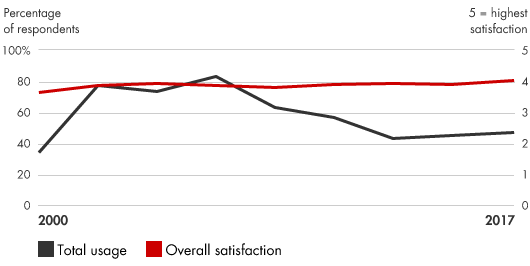Management Tools
Customer Relationship Management (CRM) is a process companies use to understand their customer groups and respond quickly—and at times, instantly—to shifting customer desires. CRM technology allows firms to collect and manage large amounts of customer data and then carry out strategies based on that information. Data collected through focused CRM initiatives helps firms solve specific problems throughout their customer relationship cycle—the chain of activities from the initial targeting of customers to efforts to win them back for more. CRM data also provides companies with important new insights into customers’ needs and behaviors, allowing them to tailor products to targeted customer segments. Information gathered through CRM programs often generates solutions to problems outside a company’s marketing functions, such as Supply Chain Management and new product development.
Usage and satisfaction among survey respondents

How Customer Relationship Management works:
CRM requires managers to:
- Start by defining strategic “pain points” in the customer relationship cycle. These are problems that have a large impact on customer satisfaction and loyalty, where solutions would lead to superior financial rewards and competitive advantage.
- Evaluate whether—and what kind of—CRM data can fix those pain points. Calculate the value that such information would bring the company.
- Select the appropriate technology platform, and calculate the cost of implementing it and training employees to use it.
- Assess whether the benefits of the CRM information outweigh the expense involved.
- Design incentive programs to ensure that personnel are encouraged to participate in the CRM program. Many companies have discovered that realigning the organization away from product groups and toward a customer-centered structure improves the success of CRM.
- Measure CRM progress and impact. Aggressively monitor participation of key personnel in the CRM program. In addition, put measurement systems in place to track the improvement in customer profitability with the use of CRM. Once the data is collected, share the information widely with employees to encourage further participation in the program.
| RELATED TOPICS | HOW BAIN CAN HELP |
|---|---|
|
Companies use Customer Relationship Management to:
- Gather market research on customers, in real time if necessary
- Generate more reliable sales forecasts
- Coordinate information quickly between sales staff and customer support reps, increasing their effectiveness
- Enable sales reps to see the financial impact of different product configurations before they set prices
- Accurately gauge the return on individual promotional programs and the effect of integrated marketing activities, and redirect spending accordingly
- Feed data on customer preferences and problems to product designers
- Increase sales by systematically identifying and managing sales leads
- Improve customer retention
- Design effective customer service programs

Management Tools & Trends
Five key trends emerged from Bain's survey of 1,268 managers.
Selected references
Day, George S. “Which Way Should You Grow?” Harvard Business Review, July/August 2004, pp. 24–26.
Dyché, Jill. The CRM Handbook: A Business Guide to Customer Relationship Management. Addison-Wesley Professional, 2001.
Peppers, Don, and Martha Rogers. Managing Customer Relationships: A Strategic Framework. 2d ed. Wiley, 2011.
Reichheld, Fred. Loyalty Rules! How Leaders Build Lasting Relationships in the Digital Age. Harvard Business School Press, 2001.
Reichheld, Fred, with Thomas Teal. The Loyalty Effect: The Hidden Force Behind Growth, Profits, and Lasting Value. Harvard Business School Press, 1996.
Rigby, Darrell K., and Dianne Ledingham. “CRM Done Right.” Harvard Business Review, November 2004, pp. 118–129.
Rigby, Darrell K., Fred Reichheld, and Phil Schefter. “Avoid the Four Perils of CRM.” Harvard Business Review, February 2002, pp. 101–109.